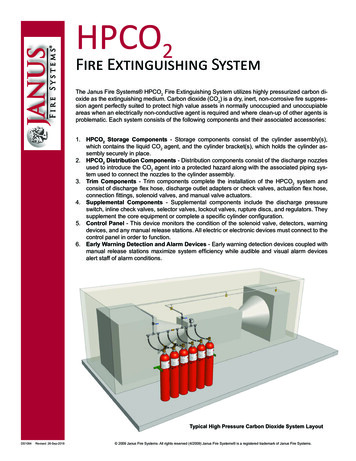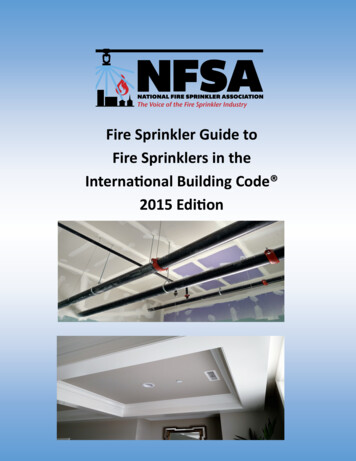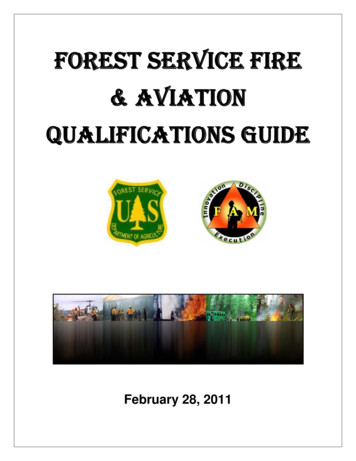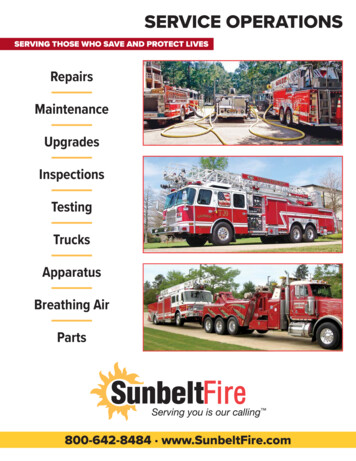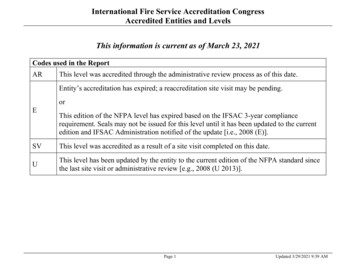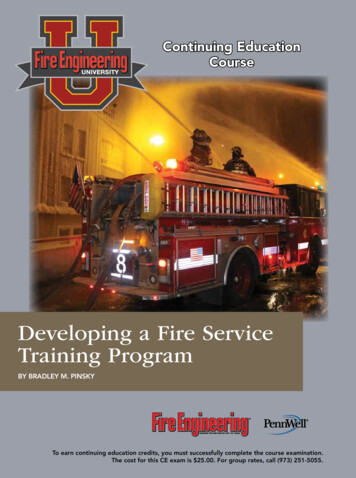
Transcription
Continuing EducationCourseDeveloping a Fire ServiceTraining ProgramBY BRADLEY M. PINSKYTRAINING THE FIRE SERVICE FOR 136 YEARSTo earn continuing education credits, you must successfully complete the course examination.The cost for this CE exam is 25.00. For group rates, call (973) 251-5055.
Developing a Fire ServiceTraining ProgramEducational ObjectivesOn completion of this course, students will1. Determine if your training programs reach their potential3. Learn how to prepare lesson plans2. How to consult your Organizational Statement whendeveloping a training program4. Discover legal requirements for trainingBY BRADLEY M. PINSKYIf we were to be honest, many of us wouldadmit that our training programs do not reach their potential. Sadly, some training programs are simply ineffective.The existence of a substandard training program increases thelikelihood of firefighter injuries and decreases the opportunitiesto perform skills properly, efficiently, and safely. Issues common to many of our training programs include the following: The training program, if one exists at all, fails to providefirefighters with the skills and knowledge to handle thedepartment’s operational functions. The required number of training hours for interior firefighters frequently is fewer than 30 hours per year. There is no training officer; or, if there is a training officer,the training officer is not qualified to develop, present, orteach the program. D epartment policies are insufficient to guide the development of training programs. The individual training programs do not follow a writtenlesson plan. The training program does not require basic skills to bepracticed enough to ensure competence. Advanced skills are not developed. M inimum standards for the performance of skills have notbeen developed or implemented. The skills of each firefighter are not evaluated on a regular basis. As a result of the above, few persons attend or participatein the training.Although many might think that these issues are limited to volunteer departments, this is not the case. Career departments facemany of the same training challenges as volunteer departments.Author’s note: Do not become overwhelmed while readingthis article and become dissuaded by the significant amountof work ahead of you. Developing a training program involves many steps, and it could take several years to build anadequate training program. Smaller departments may want toconsider consolidating training functions with ictions to provide a broader support network for an efficient and comprehensive training program.WHERE TO STARTThe first step in developing a training program is to gatherthe right team. At a minimum, the team should include the chief,the training officer (TO), and the health and safety officer (HSO).Other members of the training team could include municipal fireinstructors, line officers, experienced firefighters, and retired chiefs.Consult the Organizational StatementThe team should then look to the fire department’s organizational statement. Occupational Safety and Health Administration(OSHA) regulations require1 and National Fire Protection Association 1500, Standard on Fire Department Occupational Safetyand Health Program, suggests that the fire department adopt an“organizational statement.” Look at this statement as the strategicfocus for your department. The statement guides the TO in howto develop the training program. Although there are several components to the organizational statement, the TO should focus on(1) the services the department will provide and (2) the types oftraining the department will offer and permit firefighters to takewithin and outside of the department training.Do not confuse the organizational statement with the mission statement. The organizational statement is more specificand covers the services provided. An example follows:“The services that the department will provide to the publicare as follows, with levels stated as appropriate:–interior firefighting–scene support–rehabilitation–auto extrication–wilderness firefighting–ice rescue–rope rescue to the technical level– transporting emergency medical services to the advanced lifesupport level– fire police/traffic control– wilderness search and rescue– hazardous materials to the operations level– confined space to the awareness level.”
Table 1. Evaluation of Interior Firefighting RisksPotential Injury/Illness. Risk (1-lowest, 5-highest)Burns, smoke inhalation, suffocation. 5Illness from exposure to hazardous and toxic material. 3Electrocution and shock. 3Exhaustion, fainting, heart attacks, stroke. 5Injuries from tools, cuts, abrasions, crushing injuries. 5Falls from heights, including roofs, ladders, and other elevations. 5Injuries from falling objects. 5Falls through floors and other structures. 4Exposure to cold and heat and other environmental dangers. 5Violence from persons. 3Motor vehicle accidents from dangerous driving conditions and responses, and from being present on roadways. 5Communicable and infectious diseases. 3Drowning. 2This portion of the statement is important. It provides theTO with clear instructions on the general services firefightersmust perform. The TO must ensure that personnel are capableof delivering these services in a safe and an efficient manner.Thus, when developing the program, the TO should ensurethe following: Each service offered by the department receives adequateattention in the training program. Each firefighter is expected to provide the services inwhich they participate in the training programs. Each firefighter is capable of performing the skills to a setstandard.Stated another way, if the fire department provides a serviceto the public, the TO must provide adequate training to thedepartment members in that service.The TO is not the only official guided by the organizationalstatement. This list arms the chief with solid reasoning and support for the department’s budget. To perform the services listedin the statement, the department must be properly funded with abudget that provides the tools and equipment necessary to deliver each of these services. No services should be delivered to thepublic without adequate equipment or skills. Thus, chiefs whoface budget cuts can explain to the municipality that insufficientfunding will lead to the elimination of certain services becauseof a lack of funding for training or equipment. The municipality may then be asked which services should be eliminated toaddress such budget cuts. When the inevitable need for such service arises, the municipality will have placed the department inthe unfortunate position of not being able to provide the service.Consult the Risk Management PlanThe HSO must also reference the organizational statementas a first step in performing the job as it relates to the organizational statement and training program. NFPA 1500 refersto this as the “risk management plan,” another document firedepartments commonly overlook.The HSO is tasked with developing the risk managementplan. Development of the plan necessitates that the HSOevaluate and rate the risks to firefighters posed by the performance of each task necessary to provide each service the department offers. Once this evaluation has been completed, theHSO and the TO must ensure that adequate training is offeredto educate firefighters about the risks of performing each taskand how to limit the risks. Table 1 illustrates how an evaluation of the risks of interior firefighting might look.Once this plan is developed, the TO and HSO should ensurethat adequate training is provided to each firefighter expectedto deliver such services. Give the tasks with the highest riskrating the most attention, although no risk should ever beneglected during training.Prepare Lesson PlansIt is not possible to create a short article on how to developa lesson plan, which is a skill. Just the same, it is crucial thatthe TO be able to create an adequate lesson plan. This skill iscovered in fire instructor training courses such as Fire Instructor I (which instructs students in how to modify a genericlesson plan so that it is applicable for teaching to the specificdepartment or company) and Instructor II (which instructsstudents in how to create a lesson plan).Lesson plans provide objectives for the skills. The objectivesshould address the risks associated with the service providedas well as the skills and knowledge needed to provide theservice. Lesson plans should do the following: Indicate the target audience of the training (interior firefighters, operators, for example). Indicate the purpose of the lesson. State under what circumstances the training will occur. List what the participants will accomplish. Provide the standard used to evaluate participants’ success. List the materials needed (tools, projectors, props, and so on). Cite a written procedure or policy of the department thatunderlies the training. Cite a policy or a chapter to be read by the firefightersprior to the training class or skills evaluation session.Following are some samples of “simple” objectives: Given a two-story residence and a 24-foot ladder, firefighters shall be able to ladder a second-story window topermit firefighters to enter and exit; follow (insert nameof textbook, edition, and page). P resented with photos of various types of buildings, firefighters will correctly identify the type of building as definedby the International Building Code, in less than 30 seconds. Presented with a motor vehicle with a crushed door, firefighters will be able to remove the door using extricationtools within 10 minutes in accordance with the departwww.FireEngineeringUniversity.com
training programment’s Best Practice on Motor Vehicle Accidents (insertpage number).Another instructor, such as a company officer, should be ableto teach a well-written lesson plan. It should include talkingpoints, accurate descriptions of how to teach the program, andthe contents of the skill or subject matter to be taught. TOs donot need to reinvent the wheel; they should consult other firedepartments to obtain lesson plans that address relevant topics.Of course, the TO will likely need to adapt the lesson plan tothe home department’s practices and equipment.Training Reflects the PoliciesAsk any TO to list the challenges of the job. The lack ofpolicies to guide the training will be near the top of the list.TOs should not have to create policies on how tasks shouldbe accomplished, but they are often faced with no guidanceon how to perform such tasks. Thus, when developing aprogram on rapid intervention, a TO must be able to createtraining that implements the department’s rapid interventionpolicy and should not be expected to “make up” a lesson planbased on his expectations for a proper program.TOs who frequently find themselves without the direction of apolicy to guide the development of a lesson plan and are forced todevelop lesson plans based on their own beliefs may be accusedof implementing “their way” of performing a task. In their defense,what other choice do they have? The TO should advise the chiefand the HSO that he needs policies to guide the training.Should the TO be forced to develop a lesson plan without thebenefit of a preexisting best practice or policy, the chief or hisdesignee should review it before it is implemented.TRAINING OFFERED VS. TRAINING RECEIVEDMerely offering a training program is not sufficient to preventinjuries and illness and to increase proficiency. You must monitorthe programs to ensure that the firefighters are participating. Bothcareer and volunteer staff face challenges in this area, as busy daysboth on and off the job reduce the time available to attend training.However, since the training program was created to reduce risksof injuries and illnesses and to increase proficiency, the TO mustensure that each firefighter is capable of performing the skills andhas the knowledge associated with the performance of each service.A motto that could be employed is, “Do the skill or do the drill.”Firefighters would be offered the opportunity to take a written andskill-based exam to evaluate competency in each area.The evaluations are mini-exams based on the objectives stated ineach lesson plan. Testing in itself is a problem, as some individualsface difficulties with written exams and other methods of testing.Make the TO aware of these difficulties. Assistance in developingmini-tests may be available from community educational centers.Minimum Hours of TrainingMost departments determine the minimum number of training hours before knowing how long it will take to provide andreinforce the minimum required skills and knowledge for theservices they provide. Only after the lesson plans to teach thecourses are in place can you determine the minimum number oftraining hours that will be required.www.FireEngineeringUniversity.comThat being said, it is simply incredible how many departmentsrequire fewer than 50, 30, or even 10 hours of training per yearfor their interior firefighters. Many states require 100 hours ofannual training for career firefighters. Volunteer departmentsshould consider similar requirements.Qualifications for the TONFPA 1041, Standard for Fire Service Instructor ProfessionalQualifications, suggests that TOs should have successfully completed Fire Service Instructor I and II. For volunteer departments,this may be a tough requirement, as it necessitates approximately60 hours of education for each course. Still, the ability to modifyan existing lesson plan or to create a new lesson plan is criticalto the TO’s success. All departments should provide their TOwith this level of education.OSHA regulations require that an instructor have specific training in the area he teaches or be experienced or knowledgeablein the topic. Thus, the TO should ensure that all course instructors are qualified. Not all instructors must be members of yourfire department, however. If the TO gives some thought to thetask, he can find persons inside and outside of the fire service toteach courses. Persons knowledgeable in construction, hazardous materials, rescue techniques, hybrid vehicle construction, andmany other topics reside in and near your community.Program and Skill EvaluationNFPA 1500 suggests that the HSO continually evaluate thetraining program to determine if it is meeting the goals of reducing the risks of injury and illness. The TO should also evaluatethe firefighters’ skills to ensure that the training program isincreasing their proficiency in each of the expected tasks. TOsmust be open to criticism in this evaluation and must continuallyseek to improve the training experience and competencies.When individuals who do not have the minimum acceptableskills and requisite knowledge are identified, the TO and the HSOmust determine the reason for the training failure. Did the individual attend the training? Was a follow-up lesson offered to the individual? Was the training program inadequate or too complicated?Was there an opportunity for asking questions or enhancing theknowledge or skills if there was a failure in performing the skillset? It makes no sense to continue using an ineffective program ora poor lesson plan. All training programs can benefit from a criticalexamination and revision when necessary. It is well worth the timeto continuously reevaluate the training program, especially if thereare changing standards or new community hazards.LEGAL REQUIREMENTS FOR TRAININGOSHA regulations and NFPA 1500 contain standards for training in the fire service.2 The OSHA regulations, often known asthe “Fire Brigade Standard,” provide general minimum requirements for training. These regulations also provide some generalguidance as to the frequency of training and specific instructionon limited types of issues.The regulations require that the fire department ensures thattraining and education are conducted frequently enough toensure that each member of the department is able to performhis assigned duties and functions satisfactorily and in a safe
training program manner so as not to endanger other firefighters. At a minimum,all department members shall be provided with training at leastannually, although firefighters who are expected to perform interior structural firefighting shall be provided with an educationsession or training at least quarterly. Certainly, this should not bean acceptable standard to fire departments. It may not satisfy therequirement that the training be provided frequently enough toensure the safe performance of duties.The regulations also require that leaders and traininginstructors have additional training and education to teach aparticular skill set. The training is more comprehensive thanthat provided to members of a lower rank or those possessingfewer skills and less knowledge.OSHA regulations3 also require that the department educateits firefighters about special hazards to which they may beexposed during fire and other emergencies, such as the storage and use of flammable liquids and gases, toxic chemicals,radioactive sources, and water-reactive substances.The TO and the HSO should ensure that firefighters areprovided with training on these special hazards at least oncea year. The HSO will likely be required to conduct a survey ofthose hazards present in the department’s response area.Most fire departments are aware that federal regulationsrequire that all persons who respond to releases or potentialreleases of hazardous substances as part of the initial responsemust receive training at the first responder operations level.The TO should ensure initial and annual training on these hazardous materials issues.Evaluate responders to ensure that they understand basichazard and risk assessment techniques and hazardous materials terms; know how to perform basic control, containment, andconfinement operations within the capabilities of the fire department; know how to implement basic decontamination procedures; and understand relevant hazardous materials terminology.All potential incident commanders (ICs) must complete “Hazardous Materials Incident Command” or a course that provides thesame minimum hours of applicable course topics. The TO mustprovide annual refresher training and evaluations to the potentialICs to assess competency in this area. The department must maintain the record of the assessment and keep a record of the methodused to demonstrate competency. Documentation of a lecture andshort quiz in the training records will satisfy this requirement.The fire department must maintain a respiratory protectionprogram under both federal regulations and NFPA recommendations. Although there are a number of requirementsfor this program, the component related to the role of the TOis that the department must provide training in the hazardsto which members are exposed that require use of self-contained breathing apparatus (SCBA) and training in the properdonning and doffing of SCBA, the limitations of its use, itsmaintenance, and how to use all functions of SCBA.This training must be given annually. The TO and the HSOshould evaluate the training program as it relates to respiratoryprotection to ensure that each interior firefighter has the necessary skills and knowledge to operate in an immediately dangerous to life or health environment.A brief example of such a training policy follows:“Members must annually demonstrate knowledge of the following: Why SCBA is necessary and how improper fit, use andmaintenance can compromise the protective effect of therespirator; The limitations and capabilities of the respirator (meltingpoint, length of air, etc.); How to use it effectively and deal with malfunctions; How to inspect, don and doff, and check the seal of the maskand SCBA; Procedures for maintenance and storage; That they are able to recognize medical signs and symptomsthat limit or prevent the effective use of SCBA.”Although there is no specific requirement to provide Maydaytraining, OSHA has cited fire departments for not providing it.This training should ensure that interior firefighters know howto call a Mayday and when it is appropriate to do so. ICs alsoshould be trained in how to handle a Mayday situation.Your department likely also should be trained in the following:bloodborne pathogen and exposure control (an OSHA requirement), workplace violence training (a Department of Laborrequirement), sexual harassment (a best practice), and lockout/tagout (an OSHA requirement).RECORDKEEPINGTo prove compliance, record all training. Records serve manyfunctions, including ensuring that all individuals have completed the required level of training. They can also protect thedepartment from the adverse outcomes of litigation or government workplace safety inspections. Maintain training recordsand have them available for inspection for the duration of everyfirefighter’s service—in no event for fewer than seven years.TOs should strongly consider the use of checklists (whetheron a records management system or handwritten) to ensure thatevery member has completed the required minimum training. Serving as the TO is a daunting task indeed. Not only is thetraining program difficult to develop, but it also must be continually evaluated to ensure that it is increasing proficiency and reducingchances of injuries. TOs must be qualified to perform these tasksand must have the time and skills to carry them out. It can takeyears to develop the training program; constantly evaluate it for effectiveness. One thing is certain: A solid training program will savelife and property and prevent firefighter injuries. ENDnotes1. 29 CFR 1910.156.2. 29 CFR 1910.156.3. 29 CFR 1910.120. BRADLEY M. PINSKY is an attorney representing hundreds of fire departments throughout New York State. Heis also the municipal training officer and a captain for theManlius (NY) Fire Department in Onondaga County. He is anationally certified fire instructor II and state certified fireofficer II. He is one of the four attorneys hosting Fire Engineering’s “Fire Service Court Radio” and lectures annuallyat FDIC. He hosts a Web site at om
Continuing EducationDeveloping a Fire Service Training ProgramCOURSE EXAMINATION INFORMATIONTo receive credit and your certificate of completion for participation in this educational activity, you must complete the program post examination and receive a score of 70% or better. You have the following options for completion.Option One: Online CompletionUse this page to review the questions and mark your answers. Return to www.FireEngineeringUniversity.com and sign in. If you have notpreviously purchased the program, select it from the “Online Courses” listing and complete the online purchase process. Once purchased,the program will be added to your User History page where a Take Exam link will be provided. Click on the “Take Exam” link, complete allthe program questions, and submit your answers. An immediate grade report will be provided; on receiving a passing grade, your “Certificate of Completion” will be provided immediately for viewing and/or printing. Certificates may be viewed and/or printed anytime in thefuture by returning to the site and signing in.Option Two: Traditional CompletionYou may fax or mail your answers with payment to PennWell (see Traditional Completion Information on following page). All informationrequested must be provided to process the program for certification and credit. Be sure to complete ALL “Payment,” “Personal CertificationInformation,” “Answers,” and “Evaluation” forms. Your exam will be graded within 72 hours of receipt. On successful completion of the posttest(70% or higher), a “Certificate of Completion” will be mailed to the address provided.COURSE EXAMINATION1) If firefighters were to be honest, many would admit that trainingprograms do not reach their potentiala. Trueb. False2) Which of the following is a consequence of substandard trainingprograms?a. Decreased skillsb. Decreased proficiencyc. Decreased safetyd. All of the above3) Which of the following is an issue common to many trainingprograms?a. Department policies are insufficient to guide the development oftraining programsb. Advanced skills are not developedc. Skills of each firefighter are not evaluated on a regular basisd. All of the above4) Many firefighters think that common issues in many trainingprograms are limited to volunteer departments, but they are alsofound in career departmentsa. Trueb. False5) The first step in developing a training program is to:a. Learn the incident command systemb. Develop an Organizational Statementc. Gather the right teamd. Solicit input from senior members6) The team selected to develop a training program should consistof which of the following?a. Chiefb. Training Officerc. Health and Safety Officerd. All of the above7) After a training program development team has been selected, theteam should look at the fire department’s:a. Mission Statementb. Organizational Statementc. Vision Statementd. None of the abovewww.FireEngineeringUniversity.com8) The organizational statement is more specific than the missionstatementa. Trueb. False9) The organizational statement the with clearinstructions on the general services firefighters must performa. Chiefb. Mayorc. Health and Safety Officerd. Training Officer10) When developing the training program, the Training Officershould ensure which of the following?a. Each service offered receives adequate attention in the trainingprogramb. Each firefighter is expected to provide the services in which theyparticipate in the training programsc. Each firefighter is capable of performing the skills to a setstandardd. All of the above11) N FPA 1500 refers to the organizational statement and trainingprogram as the:a. Risk Management Planb. Vision Statementc. Contingency Pland. None of the above12) The Health and Safety Officer is tasked with developing the riskmanagement plana. Trueb. False13) No risk should ever be neglected during traininga. Trueb. False14) The objectives of a lesson plan should address theassociated with the service provided as well as the skills andknowledge need to provide the servicea. Financial impactb. Risksc. Didacticsd. None of the above
Continuing EducationDeveloping a Fire Service Training Program15) Lesson plans should do which of the following?18) O SHA regulations require that an instructor have specific training in the area he teaches or be experienced and knowledgeableon the topica. Indicate the target audienceb. List what the participants will accomplishc. List the materials neededd. All of the abovea. Trueb. False16) A lesson plan should cite a policy or a chapter to be read by thefirefighters prior to the traininga. Trueb. False17) Training officers who frequently find themselves without thedirection of a to guide the development of alesson plan may be accused of implementing “their way” ofperforming a taska. Policyb. Mentorc. Chiefd. Organizational Statement19) suggests that the Health and Safety Officercontinually evaluate the training program to determine if it ismeeting the goals of reducing the risks of injury and illnessa. NFPAb. NFPAc. NFPAd. NFPA171010011851150020) At a minimum, all department members shall be provided withtraining at leasta. Monthlyb. Bi-Monthlyc. Dailyd. AnnuallyNoteswww.FireEngineeringUniversity.com
Continuing EducationDeveloping a Fire Service Training ProgramPROGRAM COMPLETION INFORMATIONIf you wish to purchase and complete this activity traditionally (mail or fax) rather than Online, you must provide the information requestedbelow. Please be sure to select your answers carefully and complete the evaluation information. To receive credit, you must receive a score of70% or better.Complete online
ponents to the organizational statement, the To should focus on (1) the services the department will provide and (2) the types of . Development of the plan necessitates that the hSo . of textbook, edition, and page). Prese
